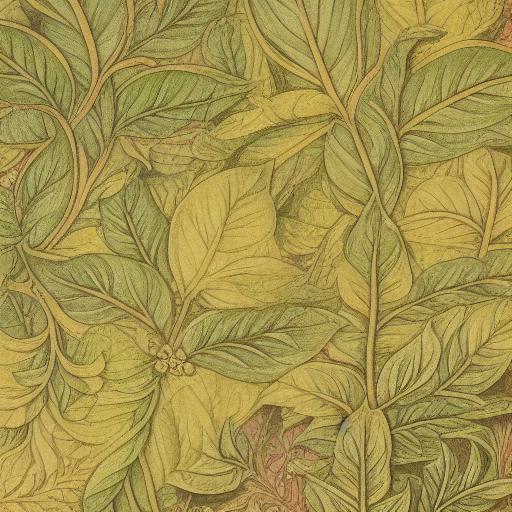How the words in Prompt affect the image generated
When generating the images by AI image generator, such as Midjourney and DALL-E, we can try to generate what we want by entering the prompt. Let’s take the image above as example to see how the keywords in the prompt affect the generated result.
The prompt “a close-up of a pattern of leaves and flowers” directs the AI to focus on the intricate details of foliage and floral elements. It suggests a zoomed-in view, highlighting the beauty and complexity of nature’s patterns.
The mention of a “mid-nineteenth-century engraving by William Morris” provides a historical context and artistic reference. William Morris was a prominent figure in the Arts and Crafts movement, known for his intricate and meticulously crafted designs. The AI draws inspiration from this artistic period and incorporates the signature style of Morris into the generated image.
The reference to the “arts and crafts movement” further influences the aesthetic of the image. The movement emphasized craftsmanship, natural motifs, and a return to traditional artistic techniques. As a result, the AI creates an engraving that reflects the principles of the arts and crafts movement, showcasing the meticulous rendering of leaves, flowers, and other botanical elements.
The prompt specifically mentions “acanthus scrolls,” a popular decorative motif in various art forms, including art nouveau. These elegant and curvilinear scrolls often featured acanthus leaves and added a sense of sophistication to the design. The AI integrates the acanthus scroll motif into the pattern, contributing to the overall ornamental appeal.
Within the art nouveau context, the prompt evokes the influence of this artistic style on the engraving. Art nouveau, characterized by its flowing lines, organic forms, and harmonious compositions, is apparent in the generated image. The AI imbues the pattern with art nouveau elements, enhancing the graceful curves and overall visual rhythm.
The mention of the color “yellow” in the prompt influences the color palette of the image. Yellow, often associated with warmth, brightness, and vitality, adds a vibrant and uplifting touch to the engraving. The AI incorporates shades of yellow in the leaves, flowers, or background, creating a visually pleasing and harmonious color scheme.
William Morris and his creation
William Morris was a prominent figure in the Art Nouveau movement, known for his multifaceted contributions as a designer, artist, and social activist. He played a significant role in shaping the aesthetics and principles of the movement, particularly in the realm of decorative arts and textile design.
Morris believed in the value of handcrafted, meticulously designed objects that reflected the beauty of nature and celebrated the skill of the craftsmen. His creations were characterized by intricate patterns, rich colors, and a strong emphasis on organic motifs inspired by plants, flowers, and animals. His designs often featured repetitive patterns and symmetrical arrangements, reflecting the influence of medieval and Renaissance art.
As a leading figure of the Arts and Crafts movement, Morris sought to counter the industrialization and mass production of the Victorian era by advocating for the revival of traditional craftsmanship and the creation of beautiful, functional objects. He established his own company, Morris & Co., which produced a wide range of decorative items, including wallpapers, textiles, furniture, and stained glass windows.
Morris’s creations embodied the principles of the Art Nouveau movement, with a focus on intricate details, harmonious compositions, and a celebration of nature’s beauty. His legacy as a designer and his commitment to the ideals of craftsmanship continue to inspire artists and designers to this day.
Leaves and details on it
Leaves is a prevalent motif in Art Nouveau design, and they play a significant role in creating the intricate and detailed aesthetics of the movement. Art Nouveau embraced the natural world and sought inspiration from organic forms, including plants, flowers, and foliage. Leaves, with their diverse shapes and delicate structures, provided an ideal source of inspiration for artists and designers.
In Art Nouveau, leaves are often depicted with great attention to detail, capturing their veins, textures, and natural curves. They are intricately incorporated into various design elements, such as borders, backgrounds, or as standalone decorative elements. The use of leaves adds a sense of rhythm, movement, and harmony to the composition, mimicking the organic growth found in nature.
The detailed rendering of leaves in Art Nouveau reflects the movement’s dedication to capturing the beauty and intricacy of the natural world. It also symbolizes a return to nature and a desire to reconnect with the organic environment amidst the rise of industrialization. By incorporating leaves into their designs, Art Nouveau artists aimed to evoke a sense of tranquility, vitality, and a deep appreciation for the wonders of the natural world.
What we can do with the generated images
The possibilities are endless with the generated results from AI image generation. You can seamlessly integrate these captivating images into your design projects, unleashing your creativity and bringing your ideas to life. Whether it’s creating stunning visuals, enhancing presentations, or adding unique elements to your work, the AI-generated images offer a wealth of inspiration. With the convenience of design tools like Visual Paradigm Online, you can easily incorporate the generated images into your design workflow, taking your creations to new heights.


